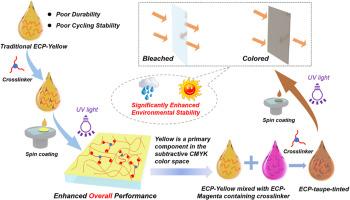交联策略有效地提高了基于prodot的电致变色聚合物和器件在极端环境条件下的稳定性
IF 6.3
2区 材料科学
Q2 ENERGY & FUELS
引用次数: 0
摘要
电致变色智能窗通过电压控制调节光透过率来调节环境温度,适用于建筑物、飞机、车辆等。基于3,4 -丙烯二氧噻吩(ProDOT)的电致变色聚合物(ECP)由于其化学可调的多色状态、快速响应和优异的可加工性,被认为在智能窗口应用中具有很高的前景。然而,用于智能窗户的ECP必须具有耐候性。3,4 -丙烯二氧噻吩-邻苯二烯黄共聚物(ECP-Yellow)具有宽的带隙和强的紫外吸收,导致其在太阳辐照下稳定性差。然而,黄色是减法CMYK中的主要成分,对于扩展基于prodot的调色板至关重要。本研究开发了一种采用X3DAZP交联剂的创新交联策略。交联ecp -黄膜的循环稳定性由1000次提高到3000次。在85°C/ 85%相对湿度(RH)测试下,未封装的交联膜的耐久性比未封装的交联膜提高2.3倍和3倍,光照强度提高100倍。通过混合黄色和品红ProDOT基聚合物得到的灰褐色材料有效地延长了ProDOT系统的颜色,交联膜也增强了耐久性和循环稳定性。用基于prodot的品红和青色材料验证了交联方案的通用性,提高了电致变色膜的稳定性。该方案为聚噻吩基电致变色窗口的研究提供了有效途径。本文章由计算机程序翻译,如有差异,请以英文原文为准。

Crosslinking strategy effectively enhances stability of ProDOT-based electrochromic polymers and devices under extreme environmental conditions
Electrochromic smart windows regulate environmental temperature by modulating optical transmittance through voltage control, which are applicable to buildings, aircraft, and vehicles. 3,4 - propylenedioxythiophene (ProDOT)-based electrochromic polymers (ECP) are considered highly promising for smart window applications due to chemically tunable multicolor states, fast response, and excellent processability. However, ECP used in smart windows must be weather resistance. 3,4 - propylenedioxythiophene-alt-phenylene yellow copolymer (ECP-Yellow) exhibits wide bandgaps and strong UV absorption, leading to poor stability of the film under solar irradiation. Yet yellow is a primary component in the subtractive CMYK and is critical for expanding ProDOT-based color palettes. This study developed an innovative crosslinking strategy employing a X3DAZP crosslinker. The cycle stability of the crosslinked ECP-Yellow film was increased from 1000 to 3000 cycles. Unencapsulated crosslinked films exhibit 2.3 - and 3 - fold improvements in durability under 85 °C/85 % relative humidity (RH) test and 100-fold intensified light exposure compared to non-crosslinked counterparts. The taupe-tinted material obtained by mixing yellow and magenta ProDOT-based polymers effectively extends the color of the ProDOT system, and the crosslinked film also enhances the durability and cyclic stability. We used ProDOT-based magenta and cyan materials to verify the universality of the crosslinking scheme, and the stability of the electrochromic film was improved. This scheme provides an effective research path for polythiophene-based electrochromic window.
求助全文
通过发布文献求助,成功后即可免费获取论文全文。
去求助
来源期刊

Solar Energy Materials and Solar Cells
工程技术-材料科学:综合
CiteScore
12.60
自引率
11.60%
发文量
513
审稿时长
47 days
期刊介绍:
Solar Energy Materials & Solar Cells is intended as a vehicle for the dissemination of research results on materials science and technology related to photovoltaic, photothermal and photoelectrochemical solar energy conversion. Materials science is taken in the broadest possible sense and encompasses physics, chemistry, optics, materials fabrication and analysis for all types of materials.
 求助内容:
求助内容: 应助结果提醒方式:
应助结果提醒方式:


